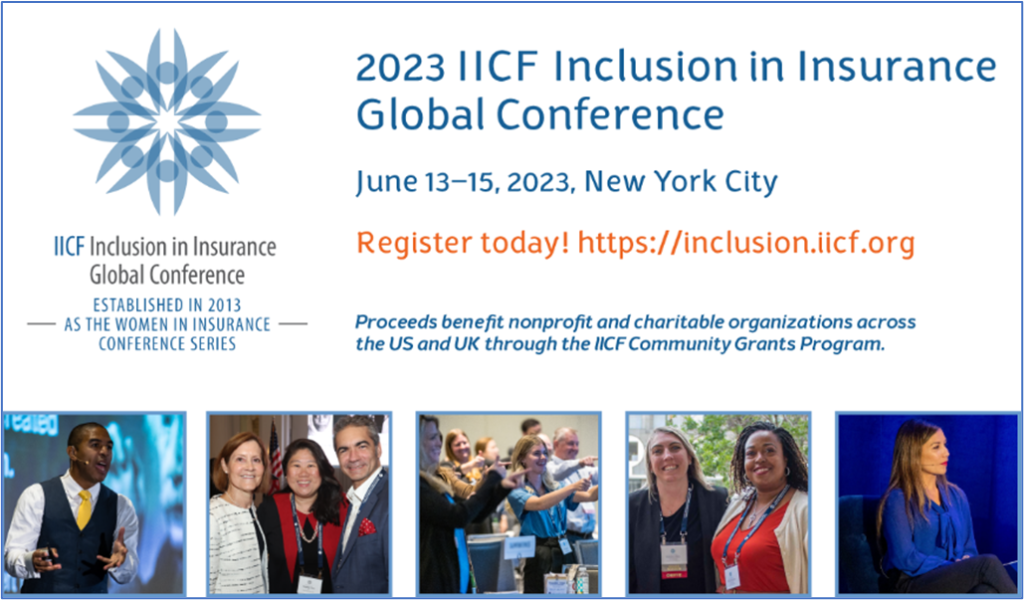
By Loretta L. Worters, Vice President, Media Relations, Triple-I
The Insurance Industry Charitable Foundation (IICF) will host its Inclusion in Insurance Global Conference June 13-15 at the New York Hilton Midtown.
The first in-person international event in the conference series since the 2019 Women in Insurance Global Conference, it will bring together hundreds of insurance professionals, C-suite executives, and experts on leadership and diversity, equity, and inclusion (DEI), along with sustainability, wellness, and business leaders for sessions dedicated to advancing ideas into action and providing actionable take-aways and strategies.
What makes any conference strong is the quality of the content and its speakers. IICF’s planning committee, which changes from year to year, is made up of industry professionals who are closest to the issues of the day, representing all areas of the United States and the United Kingdom in the planning. It’s an industry working together that makes this conference particularly powerful.
This year’s conference will feature emerging topics in leadership, personal and professional growth, the business of insurance, and the future of work.
Leadership topics include:
- Personal Finance, with Jean Chatzky — financial editor of the Today Show for 25 years and founder and CEO of HerMoney.com and the coaching programs FinanceFixx and InvestingFixx;
- Building the Public Voice of Women, with Emily Donahoe, founder/principal, WOMENSPEAK Training; and
- Navigating Intergenerational Differences, with Chris Desantis, author, speaker and podcast host of Cubicle Confidential.
Industry topics include:
- CEO Insights, shared by Ed Majkowski of EY, Hank Watkins of Lloyd’s, and Brenda Austenfield, RT Specialty;
- Moving Forward with Industry Sustainability, with Amy Brachio of EY and Jennifer Waldner of AIG; and
- Attracting Customers to the Insurance Offer (in an Inclusive Way), with Claire Burns of The Hartford.
Inclusion topics include:
- Changing the Conversation about Bias, Discrimination, and Privilege Using Brain Science, with best-selling author and speaker Eric Bailey; and
- Changing the Workplace for Good, with diversity speaker, author, and consultant Michelle Silverthorn.
Other speakers include:
- Barbara Bufkin senior advisor, Amwins;
- Carmen Duarte, vice president, Diversity, Inclusion & Social Impact, Intact Insurance Specialty Solutions; and
- Susan Johnson, chief DEI officer, The Hartford.
“IICF is thrilled to welcome such an accomplished field of speakers for the eleventh year of what was formerly known as the IICF Women in Insurance Conference Series,” said Elizabeth Myatt, vice president, chief program officer, and executive director of the IICF Northeast Division. “This event serves as a powerful catalyst for our industry as we bring together insurance professionals of all ages and career stages to discuss, learn and propel critical strategies.”

Myatt, who has led the conference since its inception, noted that it’s her favorite part of the job. “It has been wonderful to see the evolution of the conference series,” she said. “It is not just gender-focused — it is all kinds of diversity, leadership, and innovation and it’s the business of the industry itself, which has made it so valuable and meaningful to attendees.”
Myatt recognizes the importance of advancing DEI, which must be embedded in everything in the business, and everyone needs to see the shared value. She said a Congressional report this year spelled out some of the ways where the insurance industry has made an impact.
“There has been progress in gender diversity and for African-Americans, though we have not made as much progress within the Hispanic community as we’d like,” she said. “Through our conferences and the IDEA Council’s development of the IICF Talent Hub – an online resource center for non-traditional job seekers to learn about insurance industry jobs and career opportunities – and the Mentoring Alliance, which will prepare, inspire, and empower diverse talent by pairing them with role models and allies from leading companies across the industry, we are starting to see results.”
The theme for the last four years of the global conference has been advancing ideas into action, Myatt said.
“We want to provide tools, as well as new thinking. We don’t want the ideas that are shared here to stay in the room,” she said. “We plan to arm our audience with ways to make change, whether it’s personal, professional, or cultural.”
To register, for the conference, go to: https://inclusion.iicf.org/.










